
After housing, average households spend more on groceries than anything else. It's a no brainer that cutting down on your grocery bill can save you big bucks. Consider this - a savings of twenty dollars a week is more than $1000 a year! An extra thousand a year could mean many different things including a previously unaffordable vacation, or even investment in a child's education. It's never to late to start, especially with food prices set to rise even more by before the end of 2011. Below are some of the tips I use each and every time I shop to save cash and get the healthiest grub!
Planning ahead is important. A lot of people don't plan meals ahead, and unfortunately for them this can be a big money saver. Plan a week's worth of meals and write down the ingredients you'll need that you don't have on hand. When you go shopping stick to this list! If you want to be even more frugal use the weekly flyers to plan meals with the healthy foods on sale. Make sure you know your food prices though, as what may seem like a deal could be cheaper somewhere else. Couponing, although it takes a little time, is another great way to get extra savings on top already reduced prices.
Making your own meals, especially from scratch, will save a lot of money. Start your week off with a meatless-Monday. Vegetables proteins like beans, peas, nuts, lentils and tofu are super nutritious and often cheaper than their meat counterparts. For even more savings on legumes try buying them dried and in bulk. For fruits and veggies, food markets are starting to sell this time of year and usually have good prices. Stock up here or with seasonal produce at the grocery store when the price is right, and freeze what you don't eat for later use. Besides fresh, frozen is still a good choice and usually during the winter months, the cheapest. Frozen produce is just as nutritious as fresh and sometimes maybe superior as frozen foods are typically frozen immediately after harvesting, whereas fresh sometimes have to travel a distance to get us. Discount grocers like No Frills for Dominion and Price Chopper for Sobeys tend to have cheaper prices and are good for produce and prepackaged goods. Be sure to bring along your reusable shopping bags to save money and the environment too.
It's always a good idea to know how much you are paying for a unit volume of food. Be sure to pay careful attention to this during your grocery shopping. CBC's Marketplace featured a good show not too long about shrinking food packaging amongst rising food costs, so be sure to keep product size in mind.
Search the discount shelves and racks. This can often be a goldmine for good healthy foods, which most people will overlook. Half price bread and near expiration yogurts can be frozen until you want to use them. Discounted fruits can veggies can be peeled and pureed and frozen for future use. Try placing pureed fruits in ice cube trays for a quick addition to smoothies, or pureed vegetables as a base for soups. Freezing food is a great way to prolong shelf life. I know of people who anything and everything, from ripe bananas (for baking), to cheese, and coffee.
Many people who frequently grocery shop (once a week or more) probably have a several month supply of food already in their fridge, cupboards and freezer. Have you ever tried to buy only the essentials for one month and live off your current food supply? Think about it. Not only will you save cash but not buying unneeded items, you'll be able to use up the food you've already purchased before it gets freezer burnt or grows green in the fridge.
As seen in The Telegram June 27, 2011




